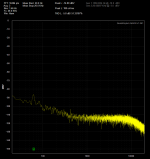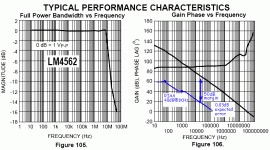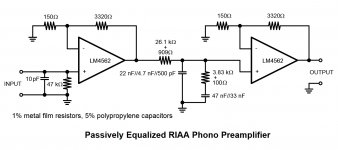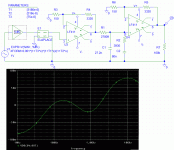G'day all, I've been using the OPA2134 in one of my DIY phono stages (ESP P06) and today for a bit of a change/experiment I replaced the both of them with LM4562's.
Yes the LM4562's are noticeably quieter, but I'm not sure if they sound as 'nice' as the OPA2134's. Certainly there seems to be more musical detail evident, but it sounds more 'sterile' to my ears. Any thoughts or comments on the LM4562's in phono stages? Regards, Felix.
Yes the LM4562's are noticeably quieter, but I'm not sure if they sound as 'nice' as the OPA2134's. Certainly there seems to be more musical detail evident, but it sounds more 'sterile' to my ears. Any thoughts or comments on the LM4562's in phono stages? Regards, Felix.
Last edited:
I'd look at three things-
1. Is one version of the circuit oscillating? That can be quite tricky to nail down since probing around with a scope can inadvertently quell things while you're looking and the frequencies can be quite high (VHF). This sort of thing is distressingly common when doing op-amp swaps.
2. Have you inadvertently changed the RIAA conformance or the circuit gain? Do a careful frequency response and gain measurement of both versions.
3. Is one op-amp more capable than the other in driving the reactive load of the RIAA network?
If "none of the above," I'd set up an ears-only test to see if the perceived difference is real.
1. Is one version of the circuit oscillating? That can be quite tricky to nail down since probing around with a scope can inadvertently quell things while you're looking and the frequencies can be quite high (VHF). This sort of thing is distressingly common when doing op-amp swaps.
2. Have you inadvertently changed the RIAA conformance or the circuit gain? Do a careful frequency response and gain measurement of both versions.
3. Is one op-amp more capable than the other in driving the reactive load of the RIAA network?
If "none of the above," I'd set up an ears-only test to see if the perceived difference is real.
G'day all, all points check out ok. I think that I've just become to used to the OPA2134 'sound'.
One thing is interesting in that with the OPA2134's in place the extended bass end of the ESP P06 seems much more noticeable, yet with the LM4562's the bass sounds 'tighter' without the almost 'bloated' bass sound of the OPA2134. Does that make sense? Regards, Felix.
One thing is interesting in that with the OPA2134's in place the extended bass end of the ESP P06 seems much more noticeable, yet with the LM4562's the bass sounds 'tighter' without the almost 'bloated' bass sound of the OPA2134. Does that make sense? Regards, Felix.
Yes the LM4562's are noticeably quieter, but I'm not sure if they sound as 'nice' as the OPA2134's. Certainly there seems to be more musical detail evident, but it sounds more 'sterile' to my ears. Any thoughts or comments on the LM4562's in phono stages?
RF sensitivity was my tentative conclusion for kicking LM4562s out of a pair of active speakers I have. Same false detail evident. You might want to check your power supply cleanliness at beyond the audio range, also the grounding. Are there any common-mode currents flowing through the 0V connection - between input and output connectors for example, or between the mains supply and the output connectors?
Tighter bass could be that the PSRR at LF is much better on the LM4562.
OPA2134 is probably the most coloured sounding operational amplifier I have ever heard. Behind its "made for audio" tagline is sweet, puffy, FET-like but muddled sound, particularly in midrange, and boosted bass region with poor definition. LM4562 is far more neutral and a good choice for RIAA circuit. The difference you hear with them is actually much more accurate sound. For RIAA applications, I would recommend LME49720 which, according to datasheets is nothing more than just a rebranded LM4562, but in listening is quieter and more analogue sounding, while retaining the 4562's neutrality.
One thing I learned when trying to use these newer high-performance op amps is that they really need more attention to layout and power supply decoupling since they are capable of working at much higher frequencies than the usual parts like NE5534. One attempt I did using the LME49990 resulted in oscillation in the 100MHz range; fortunately I was able to see this with just an oscilloscope. It did result in the chips running hot and drawing much more current than expected, along with poor sound quality. Fixing the decoupling scheme got rid of the oscillation and the sound quality was more in line with what I had expected. Don't be surprised if there is some oscillation or instability that results in a perceived change in sound quality.
As far as noise goes, depending on the impedance presented by the phono cartridge to the input, the LM4562 could be either quieter or noisier than the OPA2134. A low impedance cartridge (like, say a Grado) will run quieter with the LM4562. This I found out with the LME49990 experiment I stated just above. Quiet with a Grado, noisy as heck with an AT440MLa.
I'm doing another experiment right now with four phono stage boards, each identical except for the op amp used. The four parts are LME49710, LME49990, OPA1641, and NE5534. I just need to finish the cases for the boards, then get my measurement setup to show less power supply hum during testing (seems to be a ground loop problem; disconnect the phono stage inputs and the hum disappears from the spectrum display). Then I want to compare noise and distortion between the four op amps used in the same circuit, and do some listening tests. I don't expect to hear much difference apart from noise level, however.
I don't much believe in op amp "sound"; the "sound" appears to be caused by factors besides the op amp itself. Things like oscillation, instability, output load too low for a particular op amp, common mode distortion differences between op amps, or, in the case of JFET op amps, non linear input capacitance, although this, along with CM distortion would appear to be of limited concern at phono cartridge signal levels.
As far as noise goes, depending on the impedance presented by the phono cartridge to the input, the LM4562 could be either quieter or noisier than the OPA2134. A low impedance cartridge (like, say a Grado) will run quieter with the LM4562. This I found out with the LME49990 experiment I stated just above. Quiet with a Grado, noisy as heck with an AT440MLa.
I'm doing another experiment right now with four phono stage boards, each identical except for the op amp used. The four parts are LME49710, LME49990, OPA1641, and NE5534. I just need to finish the cases for the boards, then get my measurement setup to show less power supply hum during testing (seems to be a ground loop problem; disconnect the phono stage inputs and the hum disappears from the spectrum display). Then I want to compare noise and distortion between the four op amps used in the same circuit, and do some listening tests. I don't expect to hear much difference apart from noise level, however.
I don't much believe in op amp "sound"; the "sound" appears to be caused by factors besides the op amp itself. Things like oscillation, instability, output load too low for a particular op amp, common mode distortion differences between op amps, or, in the case of JFET op amps, non linear input capacitance, although this, along with CM distortion would appear to be of limited concern at phono cartridge signal levels.
I agree with loepke72 that power supply and oscillations are two important considerations for op-amps, in spite of the popular "swapping compatibility" fashion.
On the other hand, as much as external factors do influence the sound of an op-amp, they do show very similar, often identical, own "fingerprints" on sound in various environments.
@fap, if your LMs do not tend to get hot and if you do not experience sharp or grainy high range, then most probably they are happy.
On the other hand, as much as external factors do influence the sound of an op-amp, they do show very similar, often identical, own "fingerprints" on sound in various environments.
@fap, if your LMs do not tend to get hot and if you do not experience sharp or grainy high range, then most probably they are happy.
Some preliminary results from the phono stage "shootout" I described above:
I measured THD at 1kHz and 500mV rms out (gain of phono stage was 43.5dB) as well as noise level at 1kHz with a Shure M91ED connected to the input and ~400pF load capacitance. Distortion was .0008% on all op amps used except the LME49990, which showed a slight edge at .0006%.
Noise (I used 1kHz to get away from the effects of AC hum), however, was the deciding factor between the four op amps. Lowest noise (-114dB absolute) went to the NE5534, with the OPA1614 only 1dB worse at -113dB. The LME49710 showed a noise level of -104dB, and the LME49990 was worst of all with a level at 1kHz of -105dB, but rising to a peak of -100dB between 5-10kHz. The added load capacitance at the input is most likely responsible for a rolloff of noise with frequency; this was observed with all four units and could be altered on the spectrum display by switching out the input load capacitors.
The phono stage circuit is a conventional series feedback single op amp stage, nothing fancy.
The noise vs frequency characteristic observed with the LME49990 is evident upon listening to the noise alone through an audio system compared to the others.
The clear winners are the NE5534 and OPA1641, I'd give the edge to the 1641 due to it being a JFET part whose inputs draw negligible DC current and not requiring a coupling capacitor at the input for that reason. Nothing wrong with the other two besides they are not suited for best noise perfomance with the source impedance presented by the average moving magnet cartridge, and in the case of the LME49990, high enough to be noticeable when listening to a record in good condition. Now I cringe when seeing MM phono stages using low voltage noise parts like AD797, LT1028, LME49990 at the input. Current noise is too high on these for quietest performance with MM.
I measured THD at 1kHz and 500mV rms out (gain of phono stage was 43.5dB) as well as noise level at 1kHz with a Shure M91ED connected to the input and ~400pF load capacitance. Distortion was .0008% on all op amps used except the LME49990, which showed a slight edge at .0006%.
Noise (I used 1kHz to get away from the effects of AC hum), however, was the deciding factor between the four op amps. Lowest noise (-114dB absolute) went to the NE5534, with the OPA1614 only 1dB worse at -113dB. The LME49710 showed a noise level of -104dB, and the LME49990 was worst of all with a level at 1kHz of -105dB, but rising to a peak of -100dB between 5-10kHz. The added load capacitance at the input is most likely responsible for a rolloff of noise with frequency; this was observed with all four units and could be altered on the spectrum display by switching out the input load capacitors.
The phono stage circuit is a conventional series feedback single op amp stage, nothing fancy.
The noise vs frequency characteristic observed with the LME49990 is evident upon listening to the noise alone through an audio system compared to the others.
The clear winners are the NE5534 and OPA1641, I'd give the edge to the 1641 due to it being a JFET part whose inputs draw negligible DC current and not requiring a coupling capacitor at the input for that reason. Nothing wrong with the other two besides they are not suited for best noise perfomance with the source impedance presented by the average moving magnet cartridge, and in the case of the LME49990, high enough to be noticeable when listening to a record in good condition. Now I cringe when seeing MM phono stages using low voltage noise parts like AD797, LT1028, LME49990 at the input. Current noise is too high on these for quietest performance with MM.
G'day all, most interesting!
More tweaking and purely on the basis of 'sonics' and I ended up putting an LM4562 in the first (bass EQ) stage and an OPA2134 in the second (block gain) stage of my DIY ESP P06, and the combination sounds amazing with a dramatic sense of detail and 'attack', and musicality! Perhaps the 'apparent' noise is slightly higher with this combination, but it 'sounds' superb.
I know that some of the learned amongst us on the internet elsewhere continue to tell us that op amp 'sound' is a myth, and in all honesty I might have been in that camp as well at one time, but no longer! My ears like what they hear with this combination for whatever reason. Regards, Felix.
More tweaking and purely on the basis of 'sonics' and I ended up putting an LM4562 in the first (bass EQ) stage and an OPA2134 in the second (block gain) stage of my DIY ESP P06, and the combination sounds amazing with a dramatic sense of detail and 'attack', and musicality! Perhaps the 'apparent' noise is slightly higher with this combination, but it 'sounds' superb.
I know that some of the learned amongst us on the internet elsewhere continue to tell us that op amp 'sound' is a myth, and in all honesty I might have been in that camp as well at one time, but no longer! My ears like what they hear with this combination for whatever reason. Regards, Felix.
Lowest noise (-114dB absolute) went to the NE5534, with the OPA1614 only 1dB worse at -113dB. The LME49710 showed a noise level of -104dB, and the LME49990 was worst of all with a level at 1kHz of -105dB, but rising to a peak of -100dB between 5-10kHz.
You understand that this is about a hundred times lower than the intrinsic noise of the phono cartridge, thus totally insignificant?
You understand that this is about a hundred times lower than the intrinsic noise of the phono cartridge, thus totally insignificant?
Maybe it was the way I was attempting to make a comparative noise measurement by reading the level at a specific frequency on a spectrum display. Perhaps a screen shot of the measured noise will help:
Attachments
Has anyone simulated the LM4562 in LTSpice or measured it?
There seems to be a 5.6dB drop, from 3KHz to 20KHz.
My feeling is there's something wrong with the LTSpice model, because no one commented on losing high frequencies when comparing this chip to others, quite the contrary.
There seems to be a 5.6dB drop, from 3KHz to 20KHz.
My feeling is there's something wrong with the LTSpice model, because no one commented on losing high frequencies when comparing this chip to others, quite the contrary.
> seems to be a 5.6dB drop, from 3KHz to 20KHz.
Show your circuit.
Show the model you are using.
Set up a test with gain of 100, swept to 10MHz. The maker's spec says it will be 3dB down at 500KHz, 19dB down near 5MHz.
According to spec, the excess gain for typical phono pre is near 50dB, we expect 0.03dB error; and because RIAA slopes same-as open loop gain, a nearly consistent 0.03dB everywhere above 100Hz.
Show your circuit.
Show the model you are using.
Set up a test with gain of 100, swept to 10MHz. The maker's spec says it will be 3dB down at 500KHz, 19dB down near 5MHz.
According to spec, the excess gain for typical phono pre is near 50dB, we expect 0.03dB error; and because RIAA slopes same-as open loop gain, a nearly consistent 0.03dB everywhere above 100Hz.
Attachments
When I went have a look at the LM4562 model, I think I made have done things wrong.
So I'm enclosing the pspice .lib file and my asc RIAA simulations
Can you please correct the model file if necessary?
So I'm enclosing the pspice .lib file and my asc RIAA simulations
Can you please correct the model file if necessary?
Attachments
I can't read ASC files.
I questioned the RIAA values but they seem to be spot-on. +/-0.1dB with a perfect opamp, and a hair better with a lower performance opamp model. (Yes, I know the power pins look wrong; a quirk.)
This is a 3-part system. Put plotting probes at the junctions. Using your opamp, the gain-stages should be gain of 20 and flat to 1MHz.
I questioned the RIAA values but they seem to be spot-on. +/-0.1dB with a perfect opamp, and a hair better with a lower performance opamp model. (Yes, I know the power pins look wrong; a quirk.)
This is a 3-part system. Put plotting probes at the junctions. Using your opamp, the gain-stages should be gain of 20 and flat to 1MHz.
Attachments
The TI model for the LM4562 is known to have issues, wrong pin order and some other stuff I can't remember now. There have been attempts to fix it (google it if interested) but the tweaked models I tried were hit and miss (worked fine in some circuits, gave errors in others) so I gave up long ago and went back to the old National model, attached (it's for the LME49860 but other than max. supply voltage they are identical, rename it after .subckt if you wish). I don't know how precise it is but it's never given me unexpected / wrong results. Works fine in your circuit, I get +/-0.05dB.
Attachments
Last edited:
- Status
- This old topic is closed. If you want to reopen this topic, contact a moderator using the "Report Post" button.
- Home
- Source & Line
- Analogue Source
- The LM4562 in a phono stage.



